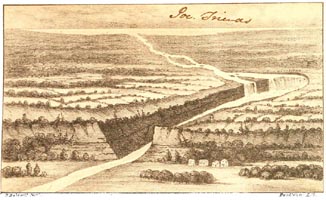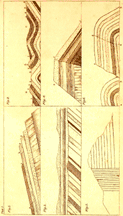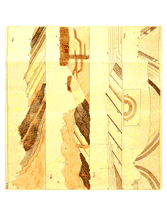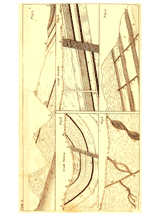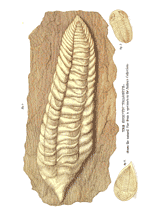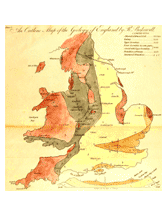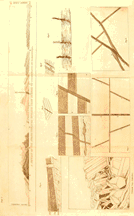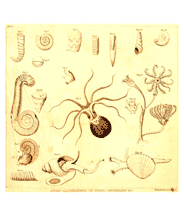PREFACE TO THE FOURTH EDITION
iii
iv
PREFACE TO THE AMERICAN Reprint of the Third Edition
v
vi
vii
PREFACE TO THE FIRST AND SECOND EDITIONS
viii
ix
x
DESCRIPTION OF THE PLATES
xvii
xviii
PRELIMINARY OBSERVATIONS on living Illustrations of Fossil
Conchology,
xix xx
xxi
xxii
xxiii
xxiv
CHAPTER
I.
001
002
003
004
005
006
007
008
009
010
011
012
013
014
015 016
017
Objects of the Science denominated Geology ....The Shape and Density of
the Earth .... Opinions respecting the internal Parts of the Globe ....
Central Heat. ....Temperature of the Earth ....Sea and dry Land ....
Proportion of the Earth's Surface habitable by Man .... On the
Appearances which led to the first Division of Rocks into Primary and
Secondary .... Classification of Rocks .... Districts in which the
different Classes appear in England .... The present Islands and
Continents formerly covered by the Ocean .... Existing Proofs of this
in Great Britain and various Parts of the World .... Fossil Remains of
marine Animals, Vegetables and Land Quadrupeds; the Strata in which
they are imbedded formed in Succession at different Epochs ....On human
Bones occasionally imbedded in Rock .... Inferences respecting the
former Condition of the Globe .... Remarkable Passage in the Institutes
of Menu.
<006> The different strata which occur under each other, are not
arranged in the order of their density or specific gravity. Coal
strata, for instance are often covered with strata of iron-stone, the
specific gravity of which is more than twice that of coal.
<015> [In the Institutes of Meno] there is a particular
definition given to the word
day
as applied to creation, and it is expressly stated to be a period of
several thousand years. If this interpretation be admitted, it will
remove the difficulty that some have felt in reconciling the epochs of
creation with the six days mentioned by Moses. The six days in which
Creative Energy renovated the globe and called into existence different
classes of animals, will imply six successive epochs of indefinite
duration.
CHAPTER
II.
ON
PETRIFACTIONS, OR FOSSIL, ANIMAL AND VEGETABLE REMAINS.
017
018
019 020
021
022
023
024
025
026
027 028
029
030
Opinions of early Naturalists respecting Petrifactions .... On the
Process called Petrifaction... Experiment of Dr. Jenner on the
Petrifaction of recent Bones .... Living Reptiles occasionally found in
solid Stone .... Remarkable Difference in the Condition of Fossil
Remains in adjacent Strata; Instance of this at Westbury Cliff,
Gloucestershire ....The four grand Divisions of the Animal Kingdom ....
Distribution of the Remains of certain Classes and Orders of Animals in
each Division, through the different Rock Formations .... Fossil
Elephant proved to have been an Inhabitant of cold Climates ....
Remains of Monkeys hitherto undiscovered in a Fossil State ....On
Vegetable Petrifactions in the Transition, Secondary and Tertiary
Strata, supposed to prove the former high Temperature of the Globe in
Northern Latitudes .... Observations on Fossil Organic Remains, as
serving to identify Strata in distant Countries.
CHAPTER
III.
ON THE MINERAL SUBSTANCES THAT COMPOSE
THE CRUST OF THE GLOBE; AND ON THE STRUCTURE OF ROCKS.
031
032
033
034
035
036
037
038
039
040
The constituent Elements of the simple Minerals that compose Rocks
....The physical Characters of simple Minerals composing Rocks ....
Explanation of the Terms employed in describing the internal Structure
of Rocks, and the external Structure of Mountain Masses ....
Sedimentary Depositions.
CHAPTER
IV.
ON STRATIFICATION, AND THE RELATIVE
POSITION OF ROCKS.
041
042
043
044
045
046
047
048
049
050
051
052
053
054
055
056
057
058
059
060
061
062
063
Strata and Geological Formations explained ....Various Appearances
presented by plane Strata .... Appearances presented by curved Strata,
and Errors respecting them .... Distinction between Strata Seams and
Natural Fissures or Cleavages .... On the conformable and unconformable
Positions of stratified and Unstratified Rocks .... The Continuity of
stratified Rocks broken by Valleys .... Longitudinal Valleys ....
Transverse Valleys .... Lateral Valleys ...Denudations.... On the
Elevation of Mountains and Mountain Chains .... On the Direction of
Mountain Chains in the new and old Continents .... On vertical Beds in
Mountains .... On the apparent devastation in Alpine Districts .... On
the Passages in the Alps called Cols; and Observations respecting their
Formation .... Different Ages of Mountain Ranges.
CHAPTER
V.
ON ROCKS DENOMINATED PRIMARY, AND
THE CHANGES TO WHICH THEY HAVE BEEN SUBJECTED.
064
065
066
067
068 069
070
The Origin of Rocks called Primary believed by many Geologists to be
igneous .... A Classification founded on this View .... A
Classification independent of Theory .... Constituent Minerals of
Granite .... Varieties of Granite .... Structure and Appearance of
Granitic Mountains .... Mont Blanc, and the Aiguilles in its Vicinity
.... Localities of Granite .... Granite Veins .... Passage of Granite
into Porphyry and Sienite .... Minerals found in Granite .... On
Granite as the Foundation Rock on which other Rocks are laid .... Tbe
relative Antiquity of different Granitic Mountain Ranges .... Granite
pierced. through by Porphyry and Currents of Lava ....Granite sometimes
protruded among the upper Strata.
CHAPTER
VI.
ON GNEISS AND MICA-SLATE, AND THE
ROCKS WHICH ARE ASSOCIATED WITH THEM.
071
072
073 074
075
076
077
078
079
080
081
On the Passage of Granite into Gneiss .... Gneiss and Granit
veiné .... Mica-Slate.... Formation of Gneiss and Mica-Slate
.... Talcous Slate, and Chlorite Slate . ....Crystalline Limestone
denominated Primary, occurs both in Primary and Secondary Mountains
.... Formation of Limestone and Coral Islands by Animal Secretion ....
Dolomite, or Alpine Magnesian Limestone .... Serpentine and Ollite, or
Potstone .... Euphotide or Saussurite the hardest and heaviest of rocks
.... Trap Rocks changed to Serpentine .... Eurite or White Stone ....
Piiniary Porphyry a Mode of Granite .... Recurrence of the same Rocks
in Rock Formations of different Epochs.
CHAPTER
VII
ON INTERMEDIATE OR TRANSITION
ROCKS.
082
083
084
085
086
087
088
089
090
091
092
093
094 095
096
097
098
099
100
Characters and Classification of Transition rocks ....
Slate or Clay-Slate .... Peculiarities of Structure ....Varieties of
Slate .... Flinty Slate .... Greywacke and Greywacke-Slate; its Passage
into Red Sandstone and Gritstone .... Errors of Geologists respecting
the old Red Sandstone .... Lower Transition Limestone: remarkable
Position of its Beds .... Upper Transition or Mountain Limestone ....
Magnesian Limestone, in Mountain Limestone .... Peculiarities in the
Stratification of Clouds Hill .... Errors respecting the Mountain
Limestone of Derbyshire .... Remarkable Structure of Crich Cliff ....
Quartz Rock .... Jasper Greenstone .... Coal Strata in England separate
the Upper Transition Rocks from the Secondary .... Observations on the
Transition Rocks of distant Countries .... Errors of Geologists
respecting them.
CHAPTER
VIII.
ON THE LOWER OR GREAT COAL
FORMATION.
101
102
103
104
105
106
107
108
109
110
111
112
113
114
115 116
117
118
119 120
121
122
123
124
125
126
The Geological Position and Structure of Coal Districts, called
Coal-Fields. Dislocation and Disturbances of Coal Strata by Faults and
Dykes .... Mineral Coal, Anthracite, Plumbago, Wood-Coal or Lignite
.... Iron-Stone accompanying Coal Strata .... On Carbon as an original
Constituent Part of the Globe .... On the Origin of Coal Strata, and
their Deposition in Freshwater Lakes or Marshes .... Numerous
Repetitions of the same Series of Beds in the same Coal-Field...
Precautions necessary in the Establishment of Iron Furnaces .... On the
Mode of searching for Coal .... Hints to landed Proprietors on the
Probability of finding Coal in Districts where it has not yet been
discovered .... On the Formation of Coal-Beds in Freshwater Lakes
....On the Couversion of Vegetable Matter into Coal .... Imperfect Coal
Formations .... Salt Springs in Coal Strata ... .Coal Mines in France
and North Arnerica .... Observation on the Consumption of Coal in
England, and the Period when the Coal-Beds will be exhausted.
CHAPTER
IX.
ON UNCONFORMABLE TRAP ROCKS AND
BASALTIC DYKES.
127
128
129
130
131
132
133
134
135
136
137
138
139
140
141
142
143
144
145
146
147
148
149
Different Positions of Trap Rocks, as overlying, imbedded, or
intersecting other Rocks .... Varieties of Trap Rocks ....Porphyry,
Porphyritic Trap, Sienite, Greentone, Clinkstone, Basalt, Amygdaloid,
and Wacke .... Passage by Gradation into each other, and into Volcanic
and Granitic Rocks .... Remarkable Instance of this Passage at
Christiania in Norway .... Mountains of Porphyritic Trap and Clinkstonc
with deep Craters .... High Stile, Cumberland; Cader Idris,
Monmouthshire .... Basaltic Dykes: Extent of the Cleveland Basalt Dyke
.... Isolated Caps of Basalt .... On interstratified Basalt ....
Remarks of Professor Sedgwick on the Protrusion of Basalt between
regular Strata .... On columnar Ranges of Basalt ....Orgnnic Remains
enveloped in Basalt .... Remarkable Basaltic Districts in Europe and
America ....Experimcnts on Basalt .... Theory of Werner .... On the
relative Age of Trap Rocks.
CHAPTER
X.
A RETROSPECTIVE VIEW OF CERTAIN
GEOLOGICAL FACTS AND INFERENCES. -- RELATIVE AGES OF MOUNTAIN RANGES.
-- PRELIMINARY
OBSERVATIONS ON THE SECONDARY STRATA.
CHAPTER
XI.
TABULAR ARRANGEMENT OF SECONDARY
STRATA. -- RED SANDSTONE. -- MAGNESIAN LIMESTONE. -- ROCK SALT AND
GYPSUM.
157
158
159
160
161
162
163
164
165
166
167
168 169
170
171
172
173 174
175
176
177
Relative Geological Position of the Secondary Class of Rocks .... Their
Mineral and Zoological Characters .... Tabular Arrangement .... New Red
Sandstone and Red Marl ....Upper, Middle, and Lower Beds, chiefly
formed of the Fragments of more ancient Rocks, broken by some great
Convulsion .... Lowest Red Sandstone, oi Rothe-todte Liegende of the
German Geologists .... Separated from the Middle Beds, by Beds of
Magnesian Limestone .... Middle and Upper Beds of Red Sandstone and
Marl; their Accordance with those of France and Germany ....Muschel
Kalk wanting in England, but probably exists in Ireland, as the Lily
Encrinite has recently been discovered there .... Magnesian Limestone
of the Northern Counties.,. .English Red Marl and Sandstone formed of
more ancient Rocks, particularly of Porphyry and Trap .... Gypsuin
accompanying Rock Salt originally Anhydrous .... Rock Salt Deposits, in
different Formations.
CHAPTER
XII.
ON THE LIAS AND OOLITIC SERIES.
178
179
180
181
182 183
184
185
186
187
188
189
190
Geological Position of Lias Clay and Limestone .... Their Mineral
Characters .... Alum-Slate in Lias .... Remarkable Organic Remains and
Characteristic Fossils .... Extent of the Lias Formation in England
.... Interesting Junctions of Lias and Red Marl .... Lias of France and
the Alps .... Oolite or Roestone, the Jura Limestone of Foreign
Geologists .... Mineral Characters, and remarkable Organic Remains ....
Lower OoIite.... Oxford or Clunch Clay .... Middle Oolites ....
Kimmeridge Clay .... Upper or Portland Oolites .... Stonesfield Slate
with Organic Remains of Insects, Birds, Flying Reptiles, and small Land
Quadrupeds .... Extent of the Oolite Formation in England, and its
abrupt Termination .... Sections of the Oolitic Series of Beds in
Yorkshire and the West of England, compared with a Section of the
Secondary Strata in Germany.
CHAPTER
XIII.
ON THE SUSSEX BEDS, OR WEALDEN,
CONTAINING REMAINS OF LAND PLANTS, AND AMPHIBIOUS AND FRESH-WATER
ANIMALS.
191
192
193
194 195
196
197
198
199
Extent of the Sussex Beds .... Their Geological Poition and Mineral
Characters .... Remarkable Organic Remains of enormous Lizards and
Plants, analogous to those of Tropical Climates found in the Sussex
Beds... Supposed Appearance of the Country when these Animals
flourished .... Petworth Limestone .... Hastings Sand and Weald Clay
.... The Wealden Beds formerly furnished the greatest Part of the Iron
manufactured in England .... Mr. Mantell's Enumeration of the Species
of Terrestrial and Freshwater Fossil Remains in the Wealden Beds ....
Observations on the Wealden Beds, and the Change from Marine to
Fresh-water Formations.
CHAPTER
XIV.
ON CHALK, AND THE SUBJACENT BEDS
OF GREEN SAND.
200
201
202
203
204
205
Extent of the Chalk Formation .... Green Sand divided into lower and
upper Green Sand by a Bed of Clay called Gilt .... Chalk Marl ....
Chalk; its Mineral Characters .... Change of Character In the Alps ....
Flints in the upper Chalk .... On the Formation of Flints ....
Remarkable Organic Remains in Chalk .... Recent Discovery of Beds
belonging to the Chalk Formation, in the United States of America ....
On the Scaglia of the Alps supposed to represent Chalk.
CHAPTER
XV.
ON THE FORMATION OF SECONDARY
LIMESTONE AND SANDSTONE, AND ON THE PROGRESSIVE DEVELOPMENT OF ORGANIC
LIFE.
206
207
208
209
210
211
212
213
214
On the Deposition of Chalk .... Whethcr formed by Animal Secretion, or
by Eruptions of Water holding calcareous Earth in Suspension or
Solution .... Mud Volcanoes .... Animal Bodies suddenly encased in
Chalk indicate the Time required to form a Stratum of a given Thickness
....Oolite and Encrinal Limestone partly formed by Animal Secretion
.... Formation of Sandstone .... Repeated Appearance of dry Land during
the Epoch when the Secondary Strata were deposited .... Progressive
Developernent of Organic Life in the Secondary and Tertiary Epochs ....
Disappearance of enormous Reptiles and chambered Shells from the Seas
of Northern Latitudes .... Probability of the lchthyosaurus existing as
a living Species in the present Seas.
CHAPTER
XVI.
ON THE LOWER OR MORE ANCIENT
TERTIARY STRATA.
215
216
217
218
219 220
221
222
223
224
225
226
227 228
229
230
231
232
233
234
235
236
Formation of Tertiary Strata in Lakes or Inland Seas .... Lakes of
North America ....Falls of Niagara .... Alternations of Marine and
Freshwater Strata .... Arrangement of the Tertiary Strata in the Paris
Basin... Plastic Clay and London Clay .... Geology of the lower Vale of
the Thames .... Remains of Crocodiles and the Nautilus in London Clay
.... Molasse of Alpnach in Switzerland, with Coal and Teeth of the
Mastodon ....
Caicaire Grossier,
or Coarse Limestone of the Paris Basin, supposed to be of the same Age
as the London Clay ....
Calcaire
Siliceux .... Gypsurn and Gypseous Marl of the Paris Basin,
containing Bones of numerous extinct Species of Land Quadrupeds ....
Remarks on their Discovery and Organization by Baron Cuvier .... Marine
Sandstone .... Millstone .... Upper Freshwater Formation .... Tertiary
Strata in the Isle of Wight .... Crag of Norfolk .... its true
Geological Position not determined .... Cliff of Brighton.
CHAPTER
XVII.
ON THE RECENT TERTIARY STRATA, OR
WHAT ARE CALLED BY SOME GEOLOGISTS QUATERNARY.
237
238
239
240
241
242
243
244
245
246
247
248
249
The Methods for determining the relative Age of Formations explained,
and their Value examined... Evidence from Position .... Evidence from
Organic Reunains .... System of M. Deshayes founded on Fossil Shells
.... Uncertainty attending the Evidence from Organic Remains ....
Arbitrary Classifications of Nauralists .... Supposed Limits to the
Transmutation of Species of Molluscous Animals examined .... System of
M. Elie Beaumont .... Geological Age of Palaeotheria.... of
Mastodons.... of Elephants.... Recent Tertiary Strata of the Basin of
the Loire ....Of the Sub-apennine Ranges .... Of the Freshwater
Formations in the Apennine Valleys .... Remarkable Intermixture of the
Skeletons of Whales, Elephants, &c. at Castello Auquata explained
by what has taken place in England .... Freshwater Limestone of
Eningen, one of the most recent Tertiary Formations .... Human
Skeletons erroneously supposed to have been found there .....
Observations on the relative Age of the Strata of Œningen.
CHAPTER
XVIII.
ON EARTHQUAKES AND VOLCANOES.
250
251
252
253
254
255
256
257
258
259
260
261
262
263
264
265
266
267
268 269
270
271
272
273 274
275
276
277
278
279
280
281
282 283
Phenomena that precede the Shock of an Earthquake .. ..Extent to which
the Waters in Lakes and Springs are agitated during Earthquakes ....
Extent to which Earthquakes are felt on Land .... More severe in
Mountains than in level countries .... Connection between Earthquakes
and Volcanoes .... Electrical Earthquakes .... First Appearance of a
Volcano .... Common Phenomena attending Volcanic Eruptions ....
Remarkable Eruption of Sumbawa in 1815 .... Long periods of Repose in
some Volcanoes ....Volcano of Popocatepti in Mexico .... Submarine
Volcanoes; their Appearance preceded by violent Agitation of the Sea
.... Submarine Volcanoes in the Azores .... in the Grecian Archipelago
.... Recent Submarine Volcano near Sicily .... Craters of Eruption ....
Craters of Elevation .... Theory of Von Buch confirmed by analogous
Geological Facts .... Eruptions of Mud and Water from Volcanoes ....
Groups of Volcanic Islands .... FalI and Extinction of a Volcano ....
Vast Extent of some ancient Volcanoes .... Extinct Volcanoes of Central
France .... Puy du Pariou, the best preserved of ancient Volcanoes ....
Extinct Volcanoes in Germany and Asia .... Pseudo.Volcanoes
....Volcanic Rocks and Products .... Observations on Volcanic Fire.
CHAPTER
XIX.
ON THE REPOSITORIES OF METALLIC
ORES.
284
285
286
287
288
289
290
291
292
293
294 295
296
297
298
299
Metallic Matter disseminated through Rocks .... Masses of Metallic Ore
....Metallic Beds .... Metallic Veins .... Rake Veins .... Flat Veins
.... Accumulated Veins, Cross Courses .... The remarkable Structure of
the Botallack Mine worked under the Sea .... On the Formation of
Metallic Ores .... Remarkable Phenomena in Mines ....Stream Works ....
Gold disseminated in the Sands of Rivers In Africa, and North and South
America .... Rocks in which certain Metallic Ores are found.
CHAPTER
XX.
ON SUBTERRANEAN RIVERS AND
CURRENTS, AND ON CAVERNS.
300
301
302
303
304
305
306
307
308
309
310
311
Occurrence of Subterranean Currents and Rivers in various Parts of the
World .... The principal Agents in the Formation of Caverns ....
Remarkable Cavern and Cascade in the Speedwell Mine, Derbyshire ....
Subterranean Currents and Caverns generally in calcareous Mountains
.... The Reason explained .... Subterranean Currents connected with the
Surface Water, deposit Animal and Vegetable Remains between ancient
Strata, proved by Facts .... Caverns with Bones of extinct Species of
Animals in Germany and France, intermixed with Human Bones, and
Implements of Industry .... Bones introduced into Caverns by
Subterranean Currents and other Causes, and at different Epochs ....
Cavern at Kirkdale, in Yorkshire .... Bones found in the Clefts and
Fissures of Rocks forming Osseous Breccia in various Parts of Europe,
and in New Holland .... Epochs of their Deposition supposed to be
different in distant Parts of the Globe.
CHAPTER
XXI.
ON THE DESTRUCTION OF MOUNTAINS,
AND THE FORMATION OF SOILS; AND ON ALLUVIAL AND DILUVIAL DEPOSITIONS.
312
313
314
315 316
317
318
319 320
321
322
323
324
325
326
327 328
329
330
331
332
333
334
Erroneous Opinions respecting the Growth of Stones, supported by the
Authority of John Locke .... On the Causes in present Operation that
wear down Rocks .... Rapid Destruction of Mountains dependent on their
Structure .... Fall of Mont Grenier in Savoy .... Breaking down of the
Barriers of Mountain Lakes .... Scattered Masses of Rock .... Increase
of Land by Alluvial Depositions in Lakes, and the Deltas of large
Rivers .... On the Formation of productive Soils ....Recent Strata
formed in Lakes .... Peat and Peat Moors .... Inundations of Sand ....
Remains of Elephants and other large Animals, found in the Diluvial
Beds in England, and the frozen Regions of Europe and Asia.
CHAPTER
XXII.
ON THE ELEVATION OF MOUNTAINS AND
CONTINENTS.
335
336
337
338
339
340
341
342
343
344
345
The Elevation of the Beds of Granite and Slate in England proved bythe
Author, in 1823, to have taken place at a much earlier Epoch than the
Elevation of the Granite of Mont Blanc .... The Facts on which this
Conclusion was founded, described and explained .... Application of
similar Conclusions to other mountain Ranges by M. Elie de Beaumont
.... Tbe Elevation of Rocks of Granite and Slate proved to have taken
place by a distinct Operation from that which upheaved Continents from
the Ocean, and at a different Epoch .... Elevation of the Mountains and
Table Land in Central Asia .... Depression of the Surface round the
Caspian Sea .... Instances of the Elevation and Submergence of the
Earth's Surface in various Parts of the Globe.
CHAPTER
XXIII.
ON THE FORMATION OF VALLEYS, AND
THE GEOLOGICAL THEORIES, RELATING TO VALLEYS AND DENUDATIONS.
346
347
348
349
350
351
352
353
354
355
356
On the Causes that have broken the Surface of the Globe .... Erosive
Action of running Water illustrated by the Process called
Hushing .... Bursting of Lakes ....
Some Valleys originally formed by Elevation or Subsidence, and
subsequently enlarged by the Action of Water .... Different Theories
respecting the Formation of Valleys .... Theory of Wernerof Hutton ....
Of Elevation .... Of the retiring Waters of the Ocean .... Theory of
Excavation and Denudation by Deluges .... Modification of this Theory
by Sir James Hall; its Application to explain Denudatlons and
Transportation of Blocks of Granite from the Alps .... Particuhr
Phenomena presented by the scattered Blocks in the Vicinity of Geneva.
Denudation of Stratified Rocks, effected by the same Causes which have
broken the Primary Rocks, and scattered their fragments into distant
Districts.
CHAPTER
XXIV.
ON THE ANCIENT TEMPERATURE OF THE
EARTH. -- ON CENTRAL HEAT, AND ON ASTRONOMICAL PHENOMENA ILLUSTRATIVE
OF GEOLOGICAL THEORIES. -- CONCLUSION.
SUPPLEMENT
TO CHAPTER VIII.
ON THE GREAT COAL FORMATION,
APPENDIX.
An Index Outline of the Geology of
England 371
371
372
373 374
375
Heights of remarkable Mountains 376
376
377
378
On the Thermal Waters of the Alps 379
379
380
381
382
On the Temperature of Mines and Wells 383
383
On the Surface of the Moon 384
384
On Orbicular Granite and Porphyry 385
385
On Freshwater Formations 386
386
Farther Observations on the Intermixture of Human Bones with those of
Bears, in the Cavern of Miallet 386
386
GLOSSARY 388
388
SUPPLEMENT BY THE EDITOR 389
389
390
391
392
393
394 395
396
397
398
399
400
401
402
403
404
405
406
407
408
409
410
411
412
413
414
415 416
417
418
419 420
421
422
423
424
425
426
427 428
429
430
431
432
433
434
435
436
437
438
439
440
441
442
443
444
445
446
447
448
449
450
451
452
453
454
455
456
457
458
459
460
461
462
463
464
465
466
[435] [Remarks by the editor Silliman]
We will not enquire whether almighty power inserted plants and animals
in mineral masses, and was thus exerted in working a long series of
useless miracles, without design or end, and therefore incredible. The
man who can believe [this] can believe anything, with or without
evidence.
The order of the physical events, discovered by geology, is the same as
that recorded by the sacred historian; that is, as far as the latter
has gone, for it was, evidently, no part of his objecvt to enter any
farther into details, than to state that the world was the work of God,
and thus he was naturally led to mention the principal divisions of
natural things, as they were successively created.
[436] Hypothesis:
1. The present
earth was formed from the ruins and fragments of an
earlier world, re-arranged and set in order during the six days of the
creation. Remark: This theory has great merit, inasmuch as
it admits, in the long-gone-by ages, of just such events and
successions as geology has proved to have taken place; but it adds a
general catasttophe, which has not happened, and it implies a
reconstruction of the crust of the planet, entirely out of its own
ruins, a supposition which is inconsistent with the state of facts.
[437] Hypothesis:
2. The present
crust of the planet has been regularly formed between the first
creation "in the beginning," and the commencement of the first day.
[439] Hypothesis:
3. The days of the
creation were periods of time of indefinite length. [Discussion
of the Hebrew "yom" = day commences on pg. 442.
[443] Six successive epochs in which
the earth was renderred fit for his habitation.
The work of the third epoch was the appearance of the dry land, and the
creation of the vegetable kingdom.
[448] The work of the fifth epoch was the creation of the inhabitants
of the waters; of the birds, winged insects, and reptiles.
The work of the sixth epoch concluded with the creation of man.
[450] Table "
Coincidences between the
Order of Events as described in Genesis, and that unfolded by
Geological Investigation."
[451] The discoveries of geology, when more matured, instead of
throwing suspicion on the truths of revelation, ... have furnished the
most overpowering evidence in behalf of one branch of these truths. The
result of these discoveries has been, in this respect, similar to those
of the Chinese and Egyptian histories, and the Indian astronomy, but
much more striking. ... We have endeavored to illustrate and
point out the consequences of the statement of Baron Cuvier, "that the
order which the cosmogony of Moses assigns to the different epochs of
creation, is precisely the same as that which has been deduced from
geological considerations."
[458] Hypothesis:
4. The succession
of geological events may have happened in the first ages of the world,
after the creation of man. Remark: This supposition is wholly
irreconcilable with facts.
[458] Hypothesis: 5.
A general
deluge will account for all the geological events that have been
desribed. Remark: This view is entirely inadmissible.
[461] "The result of all our enquiries, then, is this. We find
that the geological formations are in accordance with the Mosaic
account of the creation; but more time is required for the necessary
events of the creation than is consistent with the common understanding
of the days. The history is therefore true, but it must be understood
so as to be consistent with itself and with the facts.
It is agreed on all hands, that there may be time enough for the
primitive rocks before the first day, and if the days be regarded as
periods of time, so as to allow room for the events assigned to them,
relating to organic beings, and to the masses in which they are
entombed, all difficulty is removed.
On the contrary, if they are restricted to the usual popular sense, it
is not physically possible that the events should have happened within
the time assigned; but they did happen, and as there was no call for
miracles in cases where natural operations alone were sufficient, there
can be no doubt that sufficient time was allowed.
It is scarcely necessary to remark, that after the order and
arrangement of the creation were fully established, and man appeared on
the earth, the measures of time were, without doubt, the same as now,
and therefore we are not at liberty, as there is clearly no occasion,
to regard them in any other than the usually accepted sense."
[464] "We will now add a few remarks to believers who are not
geologists. The subject before us is not one which can be
advantageously discussed with the people at large. A wide range of
facts, and an intensive course of induction, are necessary to the
satisfactory exhibition of geological truths, and especially to
establish their connexion and harmony with the Mosaic history. It
is a subject exclusively for the learned, or at least for the studious
and the reflecting; but it can no longer be neglected with safety, by
those whose province it is to illustrate and defend the sacred
writings. The crude, vague, unskilful, and unlearned manner, in which
it has been too often treated, by those who are, to a great extent,
ignorant of the structure of the globe, or who have never studied it
with any efficient attention, can communicate only pain to those
friends of the bible, who are perfectly satisfied, after full
examination, that the relation of geology to sacred history, is now as
little understood by many theologians, and biblical critics, as
astronomy was in the time of Galileo. There is but one remedy:
theologians must study geology, or if they will not, ... they must be
satisfied to receive its demonstrated truths from those who have
learned them in the most effectual way ... they will then be convinced
that geology is not an enemy, but an ally of revealed religion...."
INDEX 467
467
468 469
470
471
472
473 474
475
476
477
478
479
WOOD-CUTS
Stratified and unstratified limestone at Clouds Hill 91
Arched stratification of Crich Cliff, Derbyshire 96
Basaltic dyke expanded on the surface 138
Section of the secondary formations 160
Lily encrinite 164
Arms of the Briarean pentacrinite 180
Restored skeleton of the ichthyosaurus 181
Restored skeleton of the plesiosaurus 181
Map of the Wealden beds in Sussex 192
Teeth of the iguanodon 195
Profile of a crocodile's head found in the Isle of Sheppey 223
Front view of the same head 223
Fossil tooth of the mastodon in the coal of Alpoach 225
Extinct volcano of Pariou 271
Abymes de Myans 317
Fossil tooth of the great mastodon and the elephant 330
Fossil tooth of the rhinoceros and the hippopotamus 331
PLATES
NOTE: High Resolution (400 ppi)
images of all figures and plates are located here.
Descriptions of the Plates: xvii-xviii





